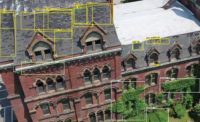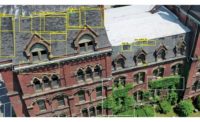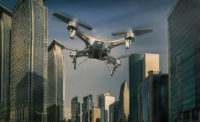When it was first introduced in 2020, T2D2 was an algorithmic computer vision system for spotting and identifying damage to building facades from inspection videos and photos. But uses of the artificial-intelligence-based system are expanding into maintenance and monitoring of structures.
“What we’ve found [in the last few years] is that there are very specific inspection requirements for different types of structures—many industries have specific needs for inspection analysis,” says Jonathan Ehrlich, T2D2's chief operating officer.
When the inspection system first spun out of structural engineer Thornton Tomasetti, it’s artificial intelligence-based algorithm had largely been trained on data from the engineer’s past work. But noticing something looks off in a photo of a facade is only the first step in providing a useful, contextual observation to an inspection engineer, according to T2D2.
“In terms of features, the AI can find lot of different conditions,” says Badri Hiriyur, founder and CEO of T2D2, and a 2020 ENR Newsmaker. “We’ve now built a suite of tools to filter through those results to find what customers must focus on.”
Rather than relying on T2D2 to only circle every possible facade crack or concrete spall, it can now track these conditions relative to the needs of the customer, and start compiling how multiple small signs of damage may indicate broader problems in a structure or facade. And as most of the visual data coming in is recorded by drones, T2D2 has worked on standardizing the reality capture standards emerging in the industry.
“Those standards were written to serve the detection tools, whether building auto-mosaics or 3D photogrammetric models,” says Hiriyur. "While those dense reality capture datasets might work if you’re trying to build a workable 3D model or digital twin of a built asset, T2D2 doesn’t require that level of detail or coverage to do its job," he adds.
“In many cases we find that clients don’t want to spend that much time in the field using drones,” says Ehrlich. “So we need visualization tools that don’t need 3D models.” Instead, the benefit is in the tagging of metadata, and compiling historical timelines of past imagery to see possible signs of deterioration.
A High-Tech Inspection for Historic Buildings
Working in historic restoration and preservation also comes with some specific demands, which T2D2 has been adapted to better serve. “It’s really fascinating, this technology they are using,” says Beth Romizer-Bailly, chief operating officer of Building Conservation Associates Inc. It has "great potential and could be the answer to the many challenges of conducting cyclical surveys of large buildings," she adds.
There is a bit of a learning curve for the AI, however. "BCA's practice is focused on historic buildings, and the complex geometry of perhaps a cathedral requires a different kind of effort than a [rectilinear] tower, but these are solvable problems," Romizer-Bailly adds.
Historic building inspection is usually a hands-on job, and T2D2’s image analysis has helped with some of BCA's larger projects. The system is only improving as it processes more information, says Romizer-Bailly.
"At first, we were concerned that the software had trouble distinguishing between shadows from prior crack repairs and actual open cracks, but the AI software allows for deep learning and constant improvement, so we are totally optimistic that software will improve at a rapid pace," she adds.
Perhaps more importantly, Romizer-Bailly sees potential for more frequent inspections using drones and T2D2 to track possible deterioration of historic structures. Drone inspection is a good idea, “especially on a large building with access issues," she says.
Drone and T2D2 inspections would allow many data-gathering visits over several years, to develop a timeline. "Right now we’re doing that with binoculars and walking around," says Romizer-Bsailly. "I think it would be a useful tool in the toolkit.”






Post a comment to this article
Report Abusive Comment